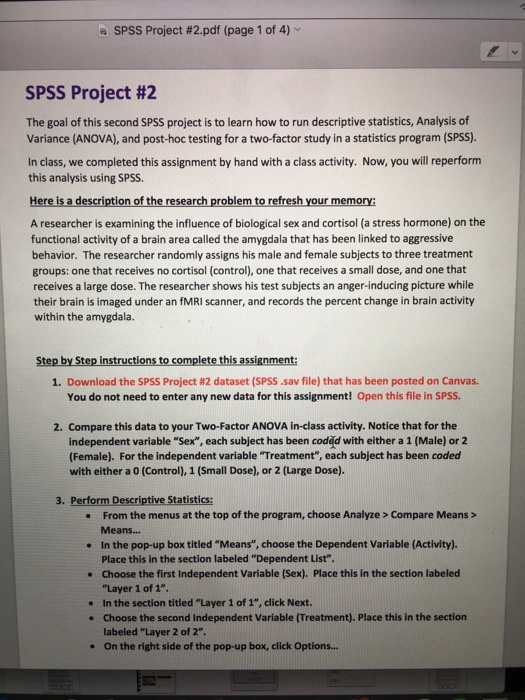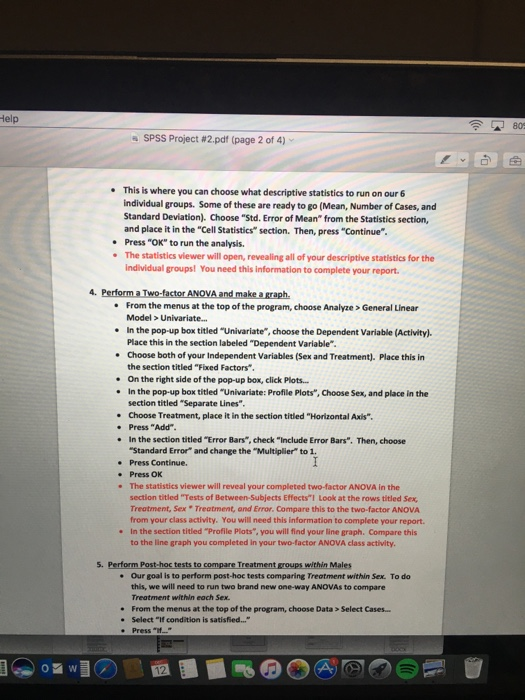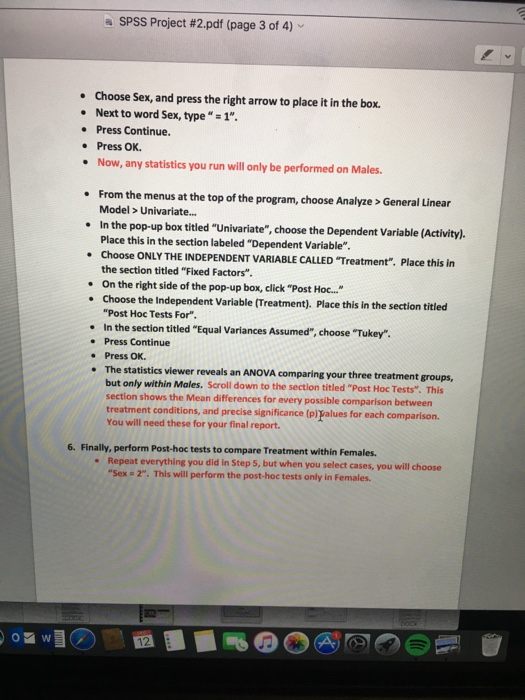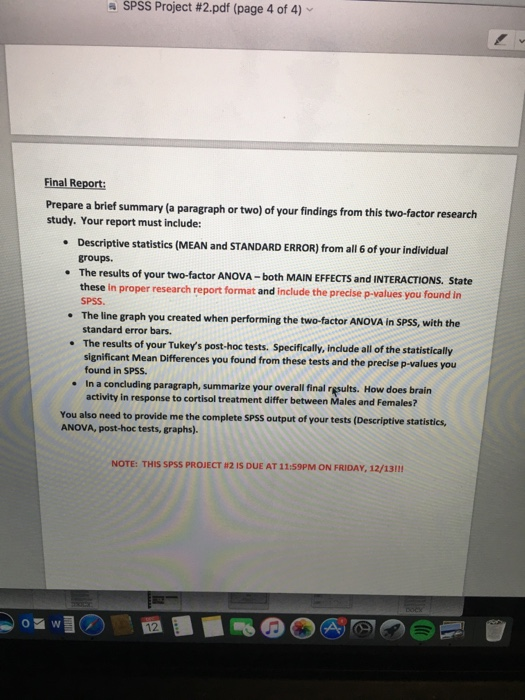Answered step by step
Verified Expert Solution
Question
1 Approved Answer
SPSS Project #2 The goal of this second SPSS project is to learn how to run descriptive statistics, Analysis of Variance (ANOVA), and post-hoc




SPSS Project #2 The goal of this second SPSS project is to learn how to run descriptive statistics, Analysis of Variance (ANOVA), and post-hoc testing for a two-factor study in a statistics program (SPSS). In class, we completed this assignment by hand with a class activity. Now, you will reperform this analysis using SPSS. SPSS Project #2.pdf (page 1 of 4) Here is a description of the research problem to refresh your memory: A researcher is examining the influence of biological sex and cortisol (a stress hormone) on the functional activity of a brain area called the amygdala that has been linked to aggressive behavior. The researcher randomly assigns his male and female subjects to three treatment groups: one that receives no cortisol (control), one that receives a small dose, and one that receives a large dose. The researcher shows his test subjects an anger-inducing picture while their brain is imaged under an fMRI scanner, and records the percent change in brain activity within the amygdala. Step by Step instructions to complete this assignment: 1. Download the SPSS Project #2 dataset (SPSS .sav file) that has been posted on Canvas. You do not need to enter any new data for this assignment! Open this file in SPSS. 2. Compare this data to your Two-Factor ANOVA in-class activity. Notice that for the independent variable "Sex", each subject has been coded with either a 1 (Male) or 2 (Female). For the independent variable "Treatment", each subject has been coded with either a 0 (Control), 1 (Small Dose), or 2 (Large Dose). 3. Perform Descriptive Statistics: mock. From the menus at the top of the program, choose Analyze > Compare Means > Means... In the pop-up box titled "Means", choose the Dependent Variable (Activity). Place this in the section labeled "Dependent List". Choose the first Independent Variable (Sex). Place this in the section labeled "Layer 1 of 1". . In the section titled "Layer 1 of 1", click Next. Choose the second Independent Variable (Treatment). Place this in the section labeled "Layer 2 of 2". . On the right side of the pop-up box, click Options... . Help W SPSS Project #2.pdf (page 2 of 4) . This is where you can choose what descriptive statistics to run on our 6 individual groups. Some of these are ready to go (Mean, Number of Cases, and Standard Deviation). Choose "Std. Error of Mean" from the Statistics section, and place it in the "Cell Statistics" section. Then, press "continue". Press "OK" to run the analysis. The statistics viewer will open, revealing all of your descriptive statistics for the individual groups! You need this information to complete your report. 4. Perform a Two-factor ANOVA and make a graph. From the menus at the top of the program, choose Analyze > General Linear Model > Univariate... In the pop-up box titled "Univariate", choose the Dependent Variable (Activity). Place this in the section labeled "Dependent Variable". Choose both of your Independent Variables (Sex and Treatment). Place this in the section titled "Fixed Factors". . On the right side of the pop-up box, click Plots.... In the pop-up box titled "Univariate: Profile Plots", Choose Sex, and place in the section titled "Separate Lines". Choose Treatment, place it in the section titled "HorizontalAxis". Press "Add". . In the section titled "Error Bars", check "Include Error Bars". Then, choose "Standard Error" and change the "Multiplier" to 1. I Press Continue. Press OK . The statistics viewer will reveal your completed two-factor ANOVA in the section titled "Tests of Between-Subjects Effects"! Look at the rows titled Sex, Treatment, Sex Treatment, and Error. Compare this to the two-factor ANOVA from your class activity. You will need this information to complete your report. . In the section titled "Profile Plots", you will find your line graph. Compare this to the line graph you completed in your two-factor ANOVA class activity. 5. Perform Post-hoc tests to compare Treatment groups within Males Our goal is to perform post-hoc tests comparing Treatment within Sex. To do this, we will need to run two brand new one-way ANOVAs to compare Treatment within each Sex. . From the menus at the top of the program, choose Data> Select Cases... Select "If condition is satisfied..." Press "if..." 12 809 W SPSS Project # 2.pdf (page 3 of 4) - Choose Sex, and press the right arrow to place it in the box. Next to word Sex, type "=1". Press Continue. Press OK. Now, any statistics you run will only be performed on Males. From the menus at the top of the program, choose Analyze > General Linear Model > Univariate... In the pop-up box titled "Univariate", choose the Dependent Variable (Activity). Place this in the section labeled "Dependent Variable". . Choose ONLY THE INDEPENDENT VARIABLE CALLED "Treatment". Place this in the section titled "Fixed Factors". On the right side of the pop-up box, click "Post Hoc..." . Choose the Independent Variable (Treatment). Place this in the section titled "Post Hoc Tests For". In the section titled "Equal Variances Assumed", choose "Tukey". Press Continue Press OK. . The statistics viewer reveals an ANOVA comparing your three treatment groups, but only within Males. Scroll down to the section titled "Post Hoc Tests". This section shows the Mean differences for every possible comparison between treatment conditions, and precise significance (p)alues for each comparison. You will need these for your final report. 6. Finally, perform Post-hoc tests to compare Treatment within Females. Repeat everything you did in Step 5, but when you select cases, you will choose "Sex = 2". This will perform the post-hoc tests only in Females. 12 SPSS Project #2.pdf (page 4 of 4) - Final Report: Prepare a brief summary (a paragraph or two) of your findings from this two-factor research study. Your report must include: W Descriptive statistics (MEAN and STANDARD ERROR) from all 6 of your individual groups. The results of your two-factor ANOVA-both MAIN EFFECTS and INTERACTIONS. State these in proper research report format and include the precise p-values you found in SPSS. The line graph you created when performing the two-factor ANOVA in SPSS, with the standard error bars. The results of your Tukey's post-hoc tests. Specifically, include all of the statistically significant Mean Differences you found from these tests and the precise p-values you found in SPSS. In a concluding paragraph, summarize your overall final results. How does brain activity in response to cortisol treatment differ between Males and Females? You also need to provide me the complete SPSS output of your tests (Descriptive statistics, ANOVA, post-hoc tests, graphs). NOTE: THIS SPSS PROJECT #2 IS DUE AT 11:59PM ON FRIDAY, 12/13!!! U
Step by Step Solution
There are 3 Steps involved in it
Step: 1
SPSS Project 2 Analysis of Cortisol and Sex on Amygdala Activity This report summarizes the findings of a twofactor study investigating the influence ...
Get Instant Access to Expert-Tailored Solutions
See step-by-step solutions with expert insights and AI powered tools for academic success
Step: 2

Step: 3

Ace Your Homework with AI
Get the answers you need in no time with our AI-driven, step-by-step assistance
Get Started


